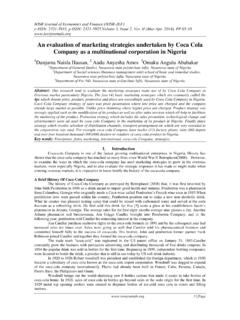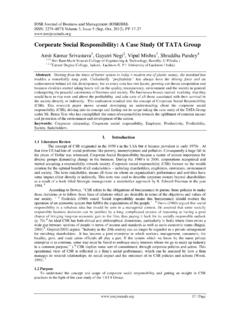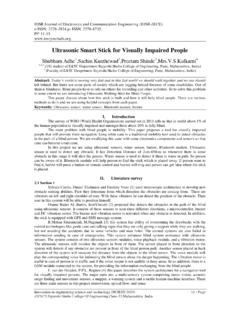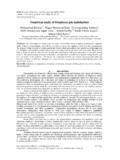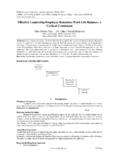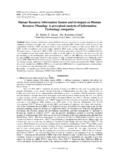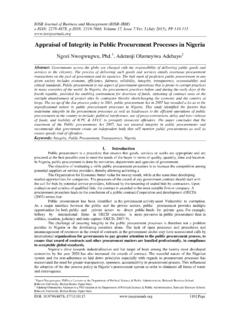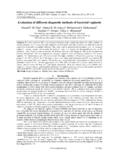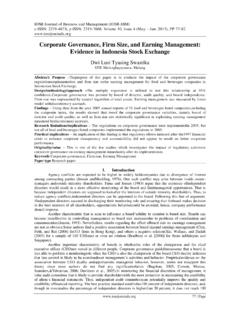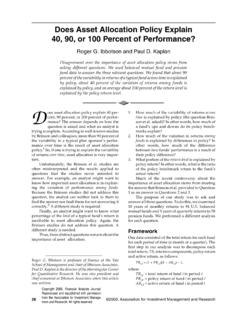Transcription of Balanced Scorecard financial measurement of …
1 IOSR Journal of Economics and Finance (IOSR-JEF) e-ISSN: 2321-5933, p-ISSN: 4, Issue 6. (Jul-Aug. 2014), PP 01-10 1 | Page Balanced Scorecard financial measurement of organizational performance: A review Dr A A Malgwi & H. Dahiru Department of Accountancy,University of Maiduguri- Nigeria Abstract: This paper reviewed some existing literature on Balanced Scorecard (BSC) as a performance tool for evaluating business organizations holistically. It makes use of four perspectives namely financial , customer, internal business process, learning and growth. Secondary sources of data were used in the review. Business managers are tasked with the responsibility of ensuring smooth operations of business activities tailored towards achieving organizational goals.
2 The review result showed that a lot of benefits have been identified by those that adopted the model despite some limitations. The paper recommended for awareness and adoption of the model to achieve organizational goals. Keywords: Balanced Scorecard , financial measurement , organizational performance. I. Introduction Achieving profitability in businesses has always been a necessary requirement for continuity, growth and expansion. Managers of organizations are tasked with the responsibilities of ensuring success of operations within their areas of control all the time, to attain this, it demands making strategic plans by the managers and using appropriate performance measurement techniques to enable them achieve their goals all the time.
3 Organizations have their mission and vision and use different strategies in ensuring the achievement of this mission in such a way that will be appropriate to both the management as well as the customers of such organization. Managers make use of only financial perspective to measure performance in the past but that seems not to be adequate enough and hence the development of a tool called the Balanced Scorecard which incorporated both the financial and non financial measures of performance, because the non- financial criteria are as important as financial criteria in measurement systemsand when both measures are integrated in the system, they lead to superior results (Kairu, Wafula,Okaka,Odera & Akerele, 2013).
4 The Balanced Scorecard was developed by Kaplan and Norton (1992) as a performance measurement framework that added strategic non- financial Performance measures to the traditional financial metrics to give managers and executives a more clear and holistic view of organizational performance. It has evolved from its early use as a simple performance measurement framework to a full strategic planning and management system. The Balanced Scorecard was devised as a result of the need to incorporate non financial variables to measure performance of an organization. The Balanced Scorecard transforms an organization s strategic plan from an attractive but passive document into the marching orders for the organization on a daily basis.
5 It provides a framework that not only provides performance measurements but helps planners identify what should be done, measured and executed Kaplan and Norton (1996a). Alao (2013) also viewed Balanced Scorecard as a system by which an organization assesses key performance measures from perspectives of performance in the financial , customer, internal business processes, learning and growth . These are means by which each member of staff performing key functions are expected to measure their performances on the job especially their contribution to organization goals of increasing organization s wealth and profitability. The application of the Balanced Scorecard involves strategizing in the use of available resources such as human manpower, finances and other resources to attain set goals.
6 A very pertinent link to maximizing organization wealth is profitability. Profit making is essential because it is the measure of performance on production of goods or services and it is the means by which the future of the firm is assured and operational improvementsare believed to cause improved financial results andincreased shareholders wealth in the long-run. Companies around the world have been making use of the financial metrics to measure their performance but this seems to be inadequate. In the past, performance measurement revolved around the use of purely accounting or financial data to gauge the performance of firms. With the emergence of the information age, in the last decades of the twentieth century, the use of only financial data as the basis for measuring performance has been observed to be inadequate to manage corporate performance of organizations in the face of global economic integration, which is characterized by integrated supply and demand chains (Muhammad 2010).
7 financial data have been criticized as being micro-oriented and have inherent lagging characteristic because financial data are compiled from only the financial perspective and use already known events. Therefore, financial data are said to possess very limited predictive ability and considered to be inadequate to Balanced Scorecard financial measurement of organizational performance: A review 2 | Page position organizations to perform effectively and efficiently and enable them to respond to customer and environmental complexities in the information age (Kaplan and Norton 1992). The main thrust of this paper is to assess the strength and weakness of this tool in measuring organizational performance.
8 Organizations are looking for a tool that will evaluate their business that will give them credibility and gain confidence of investors and shareholders. II. Conceptual framework and related Literature The concept of Balanced Scorecard According to Kaplan and Norton (1992), the Balanced Scorecard is a strategic management technique for communicating and evaluating the achievement of the mission and strategy of the organization. Atarere and Oroka ( ) were of the viewed that the balance score card provides a representation of the organization s sharedvision. The use of measurements as a language helps translate complex and frequentlynebulous concepts into a more precise form that promotes consensus among seniorexecutives.
9 The balance score card communicates a holistic model that links individualefforts and accomplishments to business unit objectives while Drury (2008) is of the view that the balance Scorecard philosophy creates a strategic focus by translating anorganization s visions and strategies into operational objectives and performancemeasures for the discernable tends to reflect the necessity of a balance between the traditional financialperspective and other non- financial elements such as customers, internal businessprocesses and innovations/improvement. It translates the organization s mission andstrategy into a comprehensive set of performance measures to provide the necessaryframework for a strategic measurement and management system that enables companies to track short term financial results while simultaneously monitoring theirprogress in developing the capabilities and acquiring the intangible assets that generategrowth for future financial performance.
10 From the above, it can be deduced that Balanced Scorecard is one of the important measurement techniques because of its ability to incorporate both financial and non financial variables in measuring organizational performance. The Balanced Scorecard is divided into four different perspectives which include financial , customer, internal business processes and learning and growth perspectives. financial perspective The financial perspective seeks to answer the question: to succeed financially, how should we appear to our shareholders? According to Al-Najjar & Kalaf (2012) financial measures convey the economic consequences for the actions already taken by the organization, and focus on the profitability related measures on which the shareholders verify the profitability of their investment.
